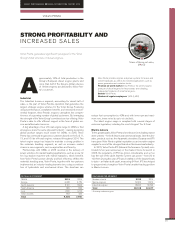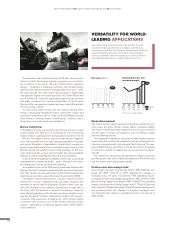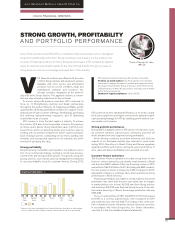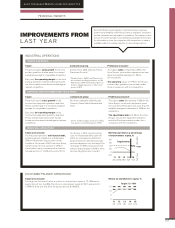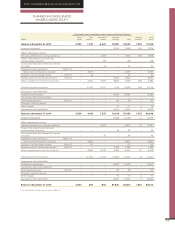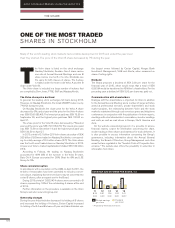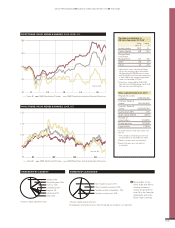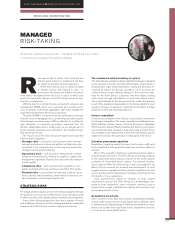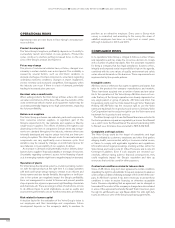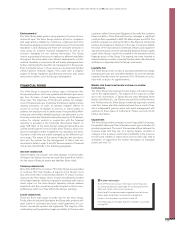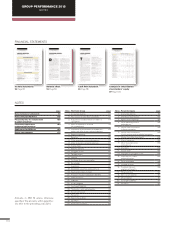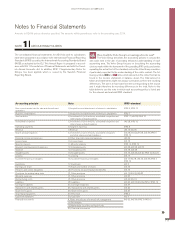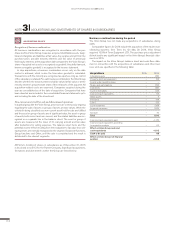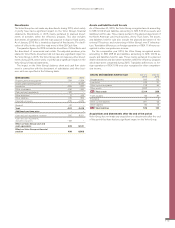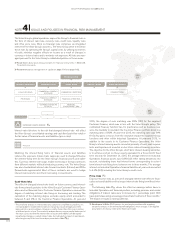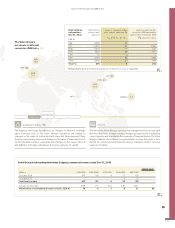Volvo 2015 Annual Report Download - page 109
Download and view the complete annual report
Please find page 109 of the 2015 Volvo annual report below. You can navigate through the pages in the report by either clicking on the pages listed below, or by using the keyword search tool below to find specific information within the annual report.
MANAGED
RISK-TAKING
All business operations involve risks – managed risk-taking is a condition
of maintaining a sustained favorable profitability.
Risks may be due to events in the world and can
affect a given industry or market and can have
an impact on the Volvo Group’s objectives.
At the Volvo Group, work is carried out daily
to identify, assess and respond to risks – in
some cases the Group can influence the likeli-
hood that a risk-related event will occur. In cases in which such
events are beyond the Group’s control, the Group strives to mini-
mize the consequences.
AB Volvo has, for a number of years, worked with enterprise risk
management (ERM), which is a systematic and structured pro-
cess to identify, understand, aggregate, report and mitigate the
risks that might threaten the Group’s objectives.
The goal of ERM is to improve business performance and opti-
mize the costs of managing risk; i.e. protecting and enhancing the
Volvo Group’s enterprise value. ERM contributes to meeting the
high standards of corporate governance expected from the
Group’s stakeholders and is looked upon as an integral part of
good corporate governance as reflected in the Swedish Corpo-
rate Governance Code.
The risks to which the Volvo Group are exposed are classified
into four main categories:
• Strategic risks – such as the cyclical nature of the commer-
cial vehicles business, intense competition, political risks, also
connected to the internal events on the long term horizon like
strategies and long term planning.
• Operational risks – such as product related events, market
reception of new products, reliance on suppliers, supply chain
management, operation of production sites and risks related to
human capital.
• Compliance risks – such as government regulations, com-
plaints and legal actions by customers and other third parties.
• Financial risks – such as financial reporting, currency fluctu-
ations, interest rate fluctuations, market value of shares or sim-
ilar instruments, credit risk and liquidity risk.
STRATEGIC RISKS
For a large global company such as Volvo Group, navigating through
the political, economic and societal trends is important and crucial
to define our place in the global context of markets and competitors.
From a Volvo Group perspective, there are a number of trends
and challenges driving our work to develop and deliver sustainable
transport and infrastructure solutions today and tomorrow.
GROUP PERFORMANCE BOARD OF DIRECTORS’ REPORT 2015
RISKS AND UNCERTAINTIES
The commercial vehicles industry is cyclical
The Volvo Group’s markets undergo significant changes in demand
as the general economic en vironment fluctuates. Investments in
infrastructure, major industrial projects, mining and housing con-
struction all impact the Group’s operations as its products are
central to these sectors. Adverse changes in the economic condi-
tions for the Volvo Group’s customers may also impact ex isting
order books through cancellations of previously placed orders.
The cyclical demand for the Group’s products makes the financial
result of the operations dependable on the Group’s ability to react
quickly to changes in demand, in particular to the ability to adapt
production levels and operating expenses.
Intense competition
Continued consolidation in the industry is expected to create fewer
but stronger competitors. The major competitors are Daimler, Iveco,
MAN, Navistar, Paccar, Scania, Sinotruk, Brunswick, Caterpillar,
CNH, Cummins, Deere, Hitachi, Komatsu and Terex. In recent years,
new competitors have emerged in Asia, particularly in China. These
new competitors are mainly active in their domestic markets, but are
expected to increase their presence in other parts of the world.
Extensive government regulation
Regulations regarding exhaust emission levels, noise, safety and
levels of pollutants from production plants are extensive within the
industry.
Most of the regulatory challenges regarding products relate to
reduced engine emissions. The Volvo Group is a leading company
in the commercial vehicle industry and one of the world’s largest
producers of heavy-duty diesel engines. The product develop-
ment capacity within the Volvo Group is well consolidated to be
able to focus resources for research and development to meet
tougher emission regulations. Future product regulations are well
known, and the product development strategy is well tuned to the
introduction of new regulations.
Local protectionism leading to changes to local content
requirements can put the Volvo Group at a disadvantage com-
pared to local competitors, cause increased sourcing costs or
require Volvo to make significant investments not necessary from
an operational point of view.
Geopolitical uncertainty
Volvo is active in more than 190 countries and political instability,
armed conflicts and civil unrest may impact Volvo’s ability to trade
in affected areas. Rapid change in inflation, devaluations or regu-
lations can sustain Volvo significant losses, impairment of assets
or costs due to underutilized assets.
107


